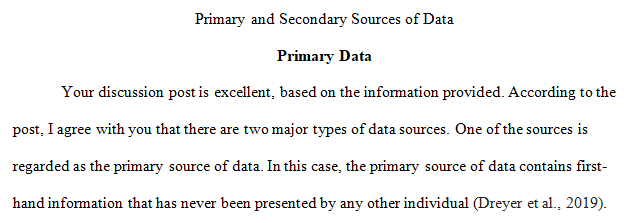
Primary and Secondary Sources of Data
Primary and Secondary Sources of Data
IMPORTANT NOTE REGARDING WORD LIMIT REQUIREMENTS:
Please note that each and every assignment has its own word limit.
Primary data source and Pros and Cons
Primary data sources are collected and observed for the first time, or the change of raw information into new forms as an outcome or event of analysis. Quantitative and Qualitative data are primary sources that collect information using interviews, surveys, focus groups, and direct observations. Quantitative data is measurable and is used when including the number of people, circumstances, and behaviors (NIH, 2018). The data is also great in determining distinct and health-related events that include one’s age, weight, demographics, and individuals suffering from a disease (NIH, 2018). Qualitative data is observed but not measured and use non-numerical information. Raw information is a good primary data source as it is important in advancing science, and the information can be reproduced or shared for future analysis. Raw data is a great way of sharing information and problematic at the same time as some researchers get different outcomes from using the raw data and some of the raw data provide problems in publication bias (Carroll et al., 2017).
Secondary data source and Pros and Cons
Secondary data sources are used to build on what has been provided by primary resources through examining, combining, and discussing the information. The Youth Risk Behavior Surveillance System would be an example of a secondary data source as this surveillance system gets information disseminated from the CDC, state, local school, health agencies, and governments (J. Michael Underwood, 2020). The (YRBSS) is very beneficial as the information provided gathers data and monitor the occurrences of health dangers, and behaviors among youths. Information that is provided to the (YRBSS) includes alcohol/drug use, violence, and unintentional injuries, sexually transmitted disease, poor physical activity, obesity, and asthma (J. Michael Underwood, 2020). Strengths of the (YRBSS) is that it can provide data that can be compared across states and among individual authorities and the nation and it is very timely when reporting results on data collection (J. Michael Underwood, 2020). Improvements of the (YRBSS) is that surveys and population reporting do not capture the results of all adolescents for accurate surveillance.
References
Carroll, H., Toumpakari, Z., Johnson, L., & Betts, J. (2017, October 24). The perceived feasibility of methods to reduce publication bias. Retrieved October 29, 2020, from https://www.ncbi.nlm.nih.gov/pmc/articles/PMC5655535/
- Michael Underwood, N. (2020, October 05). Tracking Adolescent Health Behaviors and Outcomes: Strengths and Weaknesses of the Youth Risk Behavior Surveillance System. Retrieved October 29, 2020, from https://nam.edu/tracking-adolescent-health-behavio…
National Institutes of Health. (2018, January 07). Common Data Types in Public Health Research. Retrieved October 29, 2020, from https://www.nihlibrary.nih.gov/resources/subject-g…
Respond to the bold paragraph ABOVE by using one of the option below… in APA format with At least two references and a minimum of 200 words….. .(The List of References should not be older than 2016 and should not be included in the word count.) Include at least one scholarly reference and appropriate in-text citations and Address all points on the DQ. One point will be deducted for not addressing each item mentioned above. Remember that presenting someone else’s work as your own is plagiarism.
- Ask a probing question.
- Share an insight from having read your colleague’s posting.
- Offer and support an opinion.
- Validate an idea with your own experience.
- Make a suggestion.
- Expand on your colleague’s posting.
Be sure to support your postings and responses with specific references to the Learning Resources.
It is important that you cover all the topics identified in the assignment. Covering the topic does not mean mentioning the topic BUT presenting an explanation from the context of ethics and the readings for this class
To get maximum points you need to follow the requirements listed for this assignments 1) look at the word/page limits 2) review and follow APA rules 3) create subheadings to identify the key sections you are presenting and 4) Free from typographical and sentence construction errors.
REMEMBER IN APA FORMAT JOURNAL TITLES AND VOLUME NUMBERS ARE ITALICIZED.
Subject: Masters Health & Medical
Answer preview………………………….
 apa 339 words
apa 339 words